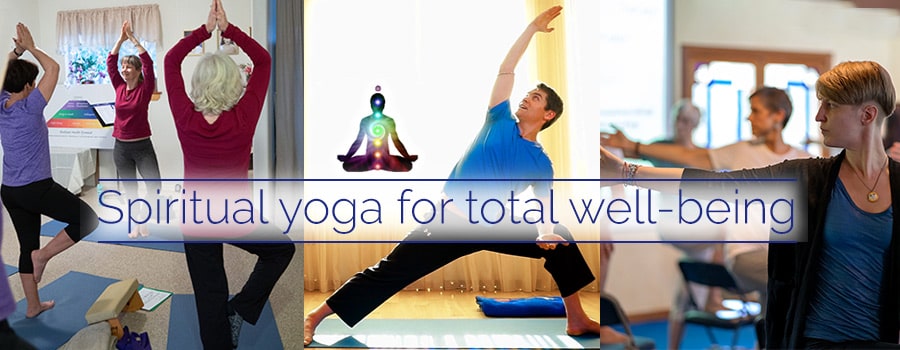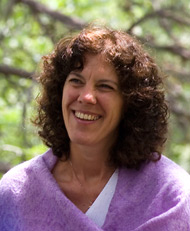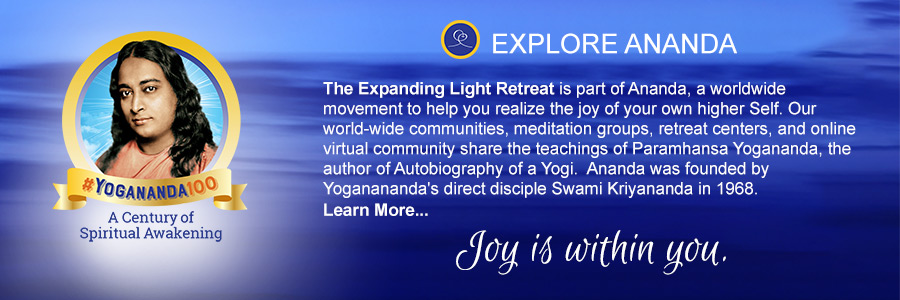Karma Yoga Comes to Light in Asana Practice
Part 1 of Asanas Can Teach Us the Deeper Side of Yoga
The path of Karma Yoga is a perfect place to start, for it offers a meaningful orientation for our daily lives.It addresses how we live, how we act and the way to inner freedom through action.
Let’s examine some of the key tenets of Karma Yoga and explore how to apply these in our practice and teaching, as well as how to begin to give our students a feel for the deeper aspects of Yoga.
Action vs. Inaction
“To act or not to act?” This question can confuse the beginning yogi, who may sometimes obsess over doing the right thing, in the right way. The beginner can become paralyzed, unable to act for fear of creating bad or unnecessary karma. Of course, such paralysis is stifling to spiritual growth.
We need to keep in mind that the real issue is not whether we are acting — after all, we can’t help but act — but how we are acting. Asana practice is a wonderful vehicle for understanding this distinction. As students cultivate an awareness of every physical movement, they’ll begin to notice the quality of energy that arises from movement, and the quality of consciousness that arises from the energy.
Gradually they’ll begin to connect their actions with the spiritual results of those actions. The reverse is true also: from consciousness flows energy and movement. How we are acting comes down to this: Do our movements make us ego-centered, or do they set us free and make us light in our bodies and thoughts? One way to help our students make this connection is through the phrasing and imagery we use. Another way is through the power of affirmations, which promote right attitude and a spirit of cooperation among body, mind and soul.
Recently the director of a nearby health club interviewed me to teach a yoga for relaxation class at her club. She came to one of my classes at our Ananda Center in Sacramento — you can imagine how different our setting is from that of a health club! — and she was very taken with the affirmations. Through them and guided imagery, for the first time in her life she experienced her body as energy and the movement of energy within the body.
Needless to say, she was thrilled! She experienced how movement can — and should — be liberating, not binding. Through acting with awareness, we can experience greater freedom.
How to Help Students Slow Down and Wake Up
As you’ve no doubt experienced, getting your students to slow down and be conscious of their movements can be challenging. For example, notice how quickly and unconsciously they’ll sometimes come out of a pose, as though the pose ended as soon as they began to come out. How much they are missing!
Verbal direction — and even your own example — won’t always correct this. One thing I’ve found that does work, however, is to repeat a pose two or three times in a row, going slower each time.
Another helpful aid is to ask students deliberately to delay part of the pose. For example, when coming out of chandrasana, ask them to stop and hold their hands overhead for longer than usual, then ask them to allow their hands to float slowly and gently down to their sides. After doing this a couple of times, they’ll feel the difference and correct themselves in other poses as well.
Another exercise that works along these same lines is what Swami Kriyananda calls “breathing your way to better spirits.” Here, we engage the breath as a channel for right action: in this case, to overcome moodiness, depression, restlessness or worry. Your students will love this!
Sit comfortably with a tall, relaxed spine. Choose a positive quality that you would like to develop. Inhale slowly and deeply. Imagine the breath filling your lungs and whole body with that quality, starting at the feet and culminating at the point between the eyebrows. Hold the breath and focus at that point for as long as is comfortable. Feel that you are burning up all negative thoughts in the blaze of divine light. As you exhale, do so forcibly, expelling forever from your body and mind any last vestiges of weakness and negativity.
Pausing Between Asanas: The Fruits of Inaction
And what of inaction? As Krishna emphasized in the Bhagavad Gita, true inaction is not a passive state. It is a heightened state in which our awareness is total.
The pauses between the poses are perfect for cultivating this state. In these priceless moments we are listening to and responding to the subtle movements of energy in our bodies and in our consciousness. Often, for me, it is after the pose that some truth or creative idea presents itself clearly and energetically to my consciousness — even without my seeking it.
For example, once during a pause in a class I was teaching, it occurred to me how much benefit there is emotionally while doing Ananda Yoga®. I thought that “yoga for emotional healing” would be a wonderful focus for classes. As it turned out, Swami Kriyananda was at that very time putting together the Secrets of Emotional Healing booklet. We started such a series at Ananda Sacramento and it’s the favorite of many of our students.
To better understand inaction, we have only to look at the great Himalayan yogis. In their lives of meditation, it can appear that they’re “doing nothing,” but in fact they are busily radiating waves of harmony and peace through the world.
In The Art and Science of Raja Yoga, Swami Kriyananda wrote “The more the yogi, by his selfless actions, develops an awareness of the divine power flowing though him, the more he realizes that he can accomplish more, even for humanity, by becoming still and serving as a transmitting station for the Infinite Power, whose sermons are Silence. Thus, outward work falls away, and the yogi’s true work becomes the upliftment of others by the silent emanations of his peace.”
In a very tangible way, the pause between poses sensitizes us to the energy around us and to our influence upon that energy field.
Sometimes it’s difficult to transition into that stillness. The mind is racing, reviewing the day and making plans. Restlessness is reinforced when mental stimulation manifests as bodily tension — for example, between the shoulders and in the arms. Poses such as sasamgasana, which actively stretch and then relax these parts, send a signal to the mind that it can relax too, that it’s okay not to be busy all the time.
Action and inaction, then, are both essential elements in a partnership with the Divine in our spiritual unfoldment. In the same way, both movement through the asana and the pause afterward are needed for a complete, balanced experience.
Desireless Practice: Nishkam Karma
Simply defined, nishkam karma means acting without desire for the fruits of action. Many students — and teachers — overlook this attitude. All too easily we fall prey to habit and/or bad example, attaching ourselves to “the great workout” or basing our “success” on whether or not we can do the difficult poses.
This was certainly my orientation when I first started in hatha yoga. I simply didn’t know better, and no one around me was suggesting a more refined approach. In my attempts to keep up with the instructor, my affirmation was usually, “If I hold this any longer, I’ll die.”
How much better off I would have been had I understood that it takes time to do a pose well, to learn its subtle aspects. As Swamiji says: “There is no such thing as failure in a pose, short of simply not doing it at all. Any stretch in the general direction indicated will be important for you.”
Nishkam karma is the most beautiful of attitudes. It immediately generates a flow of surrender and serenity. Let go of proving to yourself or anyone else — including your students! — that “I can do it.” Simply focus on doing the best you can do at the time.
Concentrate on the joy your practice gives you. Feel that joy. Whenever I see that my students have forgotten this, I gently ask them to feel the joy, smile, and radiate joy: “Fill the room with your joy. See how different you feel and where your attention now is.” No more worries, no more expectations, no more judgments. Behold, the sweetest of fruits is yours: Pure Joy! With that joy comes relaxation and ease — and eventually the ability to go deeper than you imagined possible.
The affirmation for savasana captures this perfectly: “Bones, muscles, movement, I surrender now; anxiety, elation and depression, churning thoughts — all these I give into the hands of peace.”
Serving God
Karma Yoga means acting to serve God. We all know that learning to serve is vital, but sometimes our working environment and the people around us make it difficult to do. When God’s presence isn’t obvious in other people, we may not even want to serve them.
Therefore it’s helpful to practice service in settings where it comes more naturally, such as our yoga classes. As we nurture this attitude in a supportive, God-reminding environment, our “service muscles” grow and we become better able to serve selflessly in more challenging environments.
Sometimes people say to me, “When I practice yoga, when I teach yoga, I feel so centered, calm and blissful. It’s easy to give and to want to help others. At other times it’s so challenging to behave in the highest way.” Well, that’s true for a lot of us, but it’s not the right reason for “running off to the Himalayas” or to our private yoga sanctuary. Nor can we blame our circumstances or other people. We need to learn to let the joy of yoga and meditation spill over into all that we do.
A favorite quote of mine from Swami Kriyananda’s autobiography, The Path (free online), is, “Think of Him and His energy will flow through you.” Then no matter where we are, whatever we’re doing becomes God-reminding.
When you practice Hatha Yoga, “think of Him” and feel His energy flowing through every cell of your body, moving through the breath, vibrating through bone, muscle, organs and tissue. This gets us out of the self-centered, self-limiting impulses of our heart, moving us into wholesome channels of expression. The more deliberately we practice this in Hatha Yoga, the more it will spill over into the rest of our lives. We’ll find ourselves increasingly acting in cooperation with Him.
“God is the Doer, I am His instrument.” With this attitude, everything is possible! The energy of the universe becomes ours and we experience it moving through us at all times. Our bodies change, our moods change, our thoughts change. We are transformed from a lackluster diamond to one that reflects light at every angle.
In everyday activity, if we think of God as the Doer, we’ll have more energy, limitless energy — we won’t tire so easily. But that’s not the highest incentive. Our yoga practice and teaching is not about doing more and more; it’s about going deeper in the Self. It’s about discovering who we really are, and living that realization.
“I am free! I am free!” This is the highest affirmation and the ultimate goal of Karma Yoga. If we can impart this to our students, we’ll have given them the greatest gift.
Related Articles
All authors are graduates of Ananda Yoga Teacher Training.





















